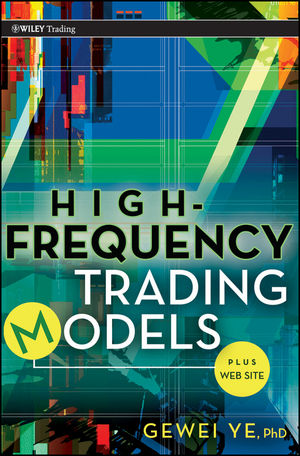High-Frequency Trading Models, + WebsiteISBN: 978-0-470-63373-1
336 pages
January 2011
|
Description
Accounting for over sixty percent of stock market trading volume and generating huge profits for a small number of firms, high frequency trading is one of the most talked about topics in the world of finance. Given the success of this approach, many firms are quickly beginning to implement their own high frequency strategies.
In High Frequency Trading Models, Dr. Gewei Ye describes the technology, architecture, and algorithms underlying current high frequency trading models, which exploit order flow imbalances and temporary pricing inefficiencies. Along the way, he explains how to develop a HFT trading system and introduces you to his own system for building high frequency strategies based on behavioral algorithms.
- Discusses how to improve current institutional HFT strategies and suggests directions for new strategies
- Companion Website includes algorithms and models discussed throughout the book
- Covers essential topics in this field, including rebate trading, arbitrage, flash trading, and other types of trading
Engaging and informative, High Frequency Trading Models is a must-read for anyone who wants to stay ahead of the curve in this hot new area.
Table of Contents
Acknowledgments.
PART I Revenue Models of High-Frequency Trading.
CHAPTER 1 High-Frequency Trading and Existing Revenue Models.
What Is High-Frequency Trading?
Why High-Frequency Trading Is Important.
Major High-Frequency Trading Firms in the United States.
Existing Revenue Models of High-Frequency Trading Operations.
Categorizing High-Frequency Trading Operations.
Conclusion.
CHAPTER 2 Roots of High-Frequency Trading in Revenue Models of Investment Management.
Revenue Model 1: Investing.
Revenue Model 2: Investment Banking.
Revenue Model 3: Market Making.
Revenue Model 4: Trading.
Revenue Model 5: Cash Management.
Revenue Model 6: Mergers and Acquisitions.
Revenue Model 7: Back-office Activities.
Revenue Model 8: Venture Capital.
Creating Your Own Revenue Model.
How to Achieve Success: Four Personal Drivers.
Conclusion.
CHAPTER 3 History and Future of High-Frequency Trading with Investment Management.
Revenue Models in the Future.
Investment Management and Financial Institutions.
High-Frequency Trading and Investment Management.
Technology Inventions to Drive Financial Inventions.
The Ultimate Goal for Models and Financial Inventions.
Conclusion.
PART II Theoretical Models as Foundation of Computer Algos for High-Frequency Trading.
CHAPTER 4 Behavioral Economics Models on Loss Aversion.
What Is Loss Aversion?
The Locus Effect.
Theory and Hypotheses.
Study 1: The Locus Effect on Inertia Equity.
Study 2: Assumption A1 and A2.
General Discussion.
Conclusion.
CHAPTER 5 Loss Aversion in Option Pricing: Integrating Two Nobel Models.
Demonstrating Loss Aversion with Computer Algos.
Visualizing the Findings.
Computer Algos for the Finding.
Explaining the Finding with the Black-Scholes Formula
Conclusion.
CHAPTER 6 Expanding the Size of Options in Option Pricing.
The NBA Event.
Web Data.
Theoretical Analysis.
The NBA Event and the Uncertainty Account.
Controlled Offline Data.
General Discussion.
Conclusion.
CHAPTER 7 Multinomial Models for Equity Returns.
Literature Review.
A Computational Framework: The MDP Model.
Implicit Consumer Decision Theory.
Empirical Approaches.
Analysis 1: Examination of Correlations and a Regression Model.
Analysis 2: Structural Equation Model.
Contributions of the ICD Theory.
Conclusion.
CHAPTER 8 More Multinomial Models and Signal Detection Models for Risk Propensity.
Multinomial Models for Retail Investor Growth.
Deriving Implicit Utility Functions.
Transforming Likeability Rating Data into Observed Frequencies.
Signal Detection Theory (SDT).
Assessing a Fund's Performance with SDT.
Assessing Value at Risk with Risk Propensity of SDT for Portfolio Managers.
Defining Risk Propensity Surface.
Conclusion.
CHAPTER 9 Behavioral Economics Models on Fund Switching and Reference Prices.
What Is VisualFunds for Fund Switching?
Behavioral Factors That Affect Fund Switching.
Theory and Predictions.
Study 1: Arbitrary Anchoring on Inertia Equity.
Study 2: Anchor Competition.
Study 3: Double Log Law.
Conclusion.
PART III A Unique Model of Sentiment Asset Pricing Engine for Portfolio Management.
CHAPTER 10 A Sentiment Asset Pricing Model.
What Is Sentiment Asset Pricing Engine?
Contributions of SAPE.
Testing the Effectiveness of SAPE Algos.
Primary Users of SAPE.
Three Implementations of SAPE.
SAPE Extensions: TopTickEngine, FundEngine, PortfolioEngine, and TestEngine.
Summary on SAPE.
Alternative Assessment Tools of Macro Investor Sentiment.
Conclusion.
CHAPTER 11 SAPE for Portfolio Management—Effectiveness and Strategies.
Contributions of SAPE to Portfolio Management.
Intraday Evidence of SAPE Effectiveness.
Trading Strategies Based on the SAPE Funds.
Case Study 1: Execution of SAPE Investment Strategies.
Case Study 2: The Trading Process with SAPE.
Case Study 3: Advanced Trading Strategies with SAPE.
Creating a Successful Fund with SAPE and High-Frequency Trading
Conclusion.
PART IV New Models of High-Frequency Trading.
CHAPTER 12 Derivatives.
What Is a Derivative?
Mortgage-Backed Securities: Linking Major Financial Institutions.
Credit Default Swaps.
Options and Option Values.
The Benefits of Using Options.
Profiting with Options.
New Profitable Financial Instruments by Writing Options.
The Black-Scholes Model As a Special Case of the Binomial Model.
Implied Volatility.
Volatility Smile.
Comparing Volatilities Over Time.
Forwards and Futures.
Pricing an Interest-Rate Swap with Prospect Theory.
The Behavioral Investing Based On Behavioral Economics.
Conclusion.
CHAPTER 13 Technology Infrastructure for Creating Computer Algos.
Web Hosting vs. Dedicated Web Servers.
Setting Up a Dedicated Web Server.
Developing Computer Algos.
Jump Starting Algo Development with PHP Programming.
Jump Starting Algo Development with Java Programming.
Jump Starting Algo Development with C++ Programming.
Jump Starting Algo Development with Flex Programming.
Jump Starting Algo Development with SQL.
Common UNIX/LINUX Commands for Algo Development.
Conclusion.
CHAPTER 14 Creating Computer Algos for High-Frequency Trading.
Getting Probability from Z Score.
Getting Z Scores from Probability.
Algos for the Sharpe Ratio.
Computing Net Present Value.
Developing a Flex User Interface for Computer Algos.
Algos for the Black-Scholes Model.
Computing Volatility with the ARCH Formula.
Algos for Monte Carlo Simulations.
Algos for an Efficient Portfolio Frontier.
Algos for Signal Detection Theory (SDT).
Conclusion.
Notes.
References.
About the Author.
Index.











